A Comprehensive Report on Monitoring Central Venous Pressure (CVP)
VerifiedAdded on 2023/03/31
|7
|2542
|336
Report
AI Summary
This report provides a comprehensive overview of central venous pressure (CVP) monitoring, a critical aspect of patient care, particularly in critical and intensive care settings. It begins by defining CVP and its relationship to right atrial pressure, outlining the factors that influence CVP readings, such as blood volume, cardiac output, and vascular compliance. The report details both manual and electronic methods of CVP measurement, including the necessary equipment, procedures, and the importance of correct transducer placement and calibration. It also examines the factors that can impact the accuracy of CVP readings, such as mechanical ventilation and patient positioning. Furthermore, the report discusses the clinical significance of CVP, including its role in assessing fluid status, guiding fluid resuscitation, and monitoring hemodynamic stability. It highlights the potential adverse effects associated with CVP monitoring, such as infection and catheter-related complications, and emphasizes the importance of aseptic techniques and adherence to guidelines for preventing catheter-related infections. The report concludes by outlining the responsibilities of nurses in CVP monitoring, including obtaining informed consent, maintaining transducer pressure, ensuring accurate readings, and recognizing and responding to potential complications. Overall, this report provides valuable insights into the practical aspects of CVP monitoring, emphasizing its importance in clinical decision-making and patient safety.
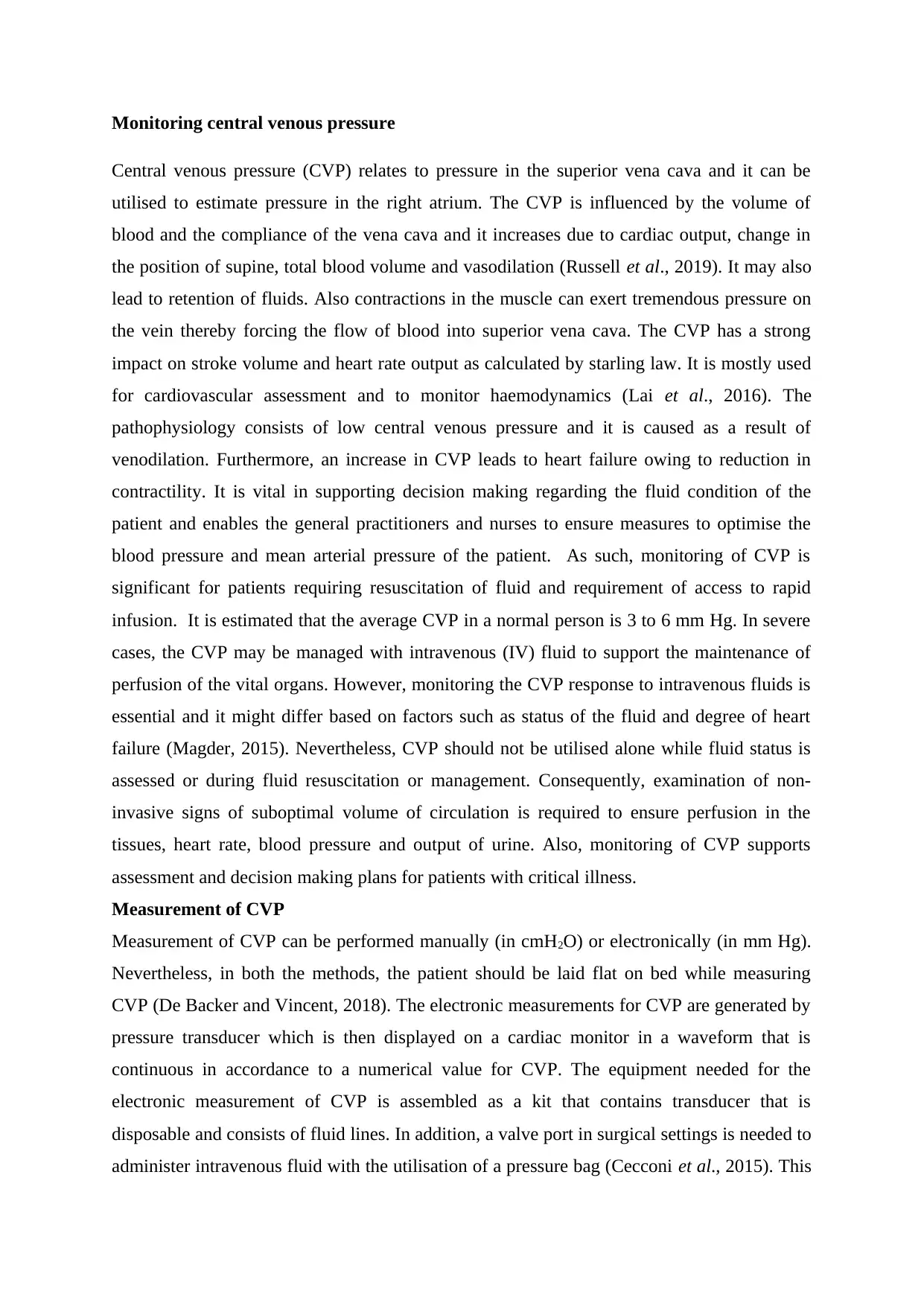
Monitoring central venous pressure
Central venous pressure (CVP) relates to pressure in the superior vena cava and it can be
utilised to estimate pressure in the right atrium. The CVP is influenced by the volume of
blood and the compliance of the vena cava and it increases due to cardiac output, change in
the position of supine, total blood volume and vasodilation (Russell et al., 2019). It may also
lead to retention of fluids. Also contractions in the muscle can exert tremendous pressure on
the vein thereby forcing the flow of blood into superior vena cava. The CVP has a strong
impact on stroke volume and heart rate output as calculated by starling law. It is mostly used
for cardiovascular assessment and to monitor haemodynamics (Lai et al., 2016). The
pathophysiology consists of low central venous pressure and it is caused as a result of
venodilation. Furthermore, an increase in CVP leads to heart failure owing to reduction in
contractility. It is vital in supporting decision making regarding the fluid condition of the
patient and enables the general practitioners and nurses to ensure measures to optimise the
blood pressure and mean arterial pressure of the patient. As such, monitoring of CVP is
significant for patients requiring resuscitation of fluid and requirement of access to rapid
infusion. It is estimated that the average CVP in a normal person is 3 to 6 mm Hg. In severe
cases, the CVP may be managed with intravenous (IV) fluid to support the maintenance of
perfusion of the vital organs. However, monitoring the CVP response to intravenous fluids is
essential and it might differ based on factors such as status of the fluid and degree of heart
failure (Magder, 2015). Nevertheless, CVP should not be utilised alone while fluid status is
assessed or during fluid resuscitation or management. Consequently, examination of non-
invasive signs of suboptimal volume of circulation is required to ensure perfusion in the
tissues, heart rate, blood pressure and output of urine. Also, monitoring of CVP supports
assessment and decision making plans for patients with critical illness.
Measurement of CVP
Measurement of CVP can be performed manually (in cmH2O) or electronically (in mm Hg).
Nevertheless, in both the methods, the patient should be laid flat on bed while measuring
CVP (De Backer and Vincent, 2018). The electronic measurements for CVP are generated by
pressure transducer which is then displayed on a cardiac monitor in a waveform that is
continuous in accordance to a numerical value for CVP. The equipment needed for the
electronic measurement of CVP is assembled as a kit that contains transducer that is
disposable and consists of fluid lines. In addition, a valve port in surgical settings is needed to
administer intravenous fluid with the utilisation of a pressure bag (Cecconi et al., 2015). This
Central venous pressure (CVP) relates to pressure in the superior vena cava and it can be
utilised to estimate pressure in the right atrium. The CVP is influenced by the volume of
blood and the compliance of the vena cava and it increases due to cardiac output, change in
the position of supine, total blood volume and vasodilation (Russell et al., 2019). It may also
lead to retention of fluids. Also contractions in the muscle can exert tremendous pressure on
the vein thereby forcing the flow of blood into superior vena cava. The CVP has a strong
impact on stroke volume and heart rate output as calculated by starling law. It is mostly used
for cardiovascular assessment and to monitor haemodynamics (Lai et al., 2016). The
pathophysiology consists of low central venous pressure and it is caused as a result of
venodilation. Furthermore, an increase in CVP leads to heart failure owing to reduction in
contractility. It is vital in supporting decision making regarding the fluid condition of the
patient and enables the general practitioners and nurses to ensure measures to optimise the
blood pressure and mean arterial pressure of the patient. As such, monitoring of CVP is
significant for patients requiring resuscitation of fluid and requirement of access to rapid
infusion. It is estimated that the average CVP in a normal person is 3 to 6 mm Hg. In severe
cases, the CVP may be managed with intravenous (IV) fluid to support the maintenance of
perfusion of the vital organs. However, monitoring the CVP response to intravenous fluids is
essential and it might differ based on factors such as status of the fluid and degree of heart
failure (Magder, 2015). Nevertheless, CVP should not be utilised alone while fluid status is
assessed or during fluid resuscitation or management. Consequently, examination of non-
invasive signs of suboptimal volume of circulation is required to ensure perfusion in the
tissues, heart rate, blood pressure and output of urine. Also, monitoring of CVP supports
assessment and decision making plans for patients with critical illness.
Measurement of CVP
Measurement of CVP can be performed manually (in cmH2O) or electronically (in mm Hg).
Nevertheless, in both the methods, the patient should be laid flat on bed while measuring
CVP (De Backer and Vincent, 2018). The electronic measurements for CVP are generated by
pressure transducer which is then displayed on a cardiac monitor in a waveform that is
continuous in accordance to a numerical value for CVP. The equipment needed for the
electronic measurement of CVP is assembled as a kit that contains transducer that is
disposable and consists of fluid lines. In addition, a valve port in surgical settings is needed to
administer intravenous fluid with the utilisation of a pressure bag (Cecconi et al., 2015). This
Paraphrase This Document
Need a fresh take? Get an instant paraphrase of this document with our AI Paraphraser
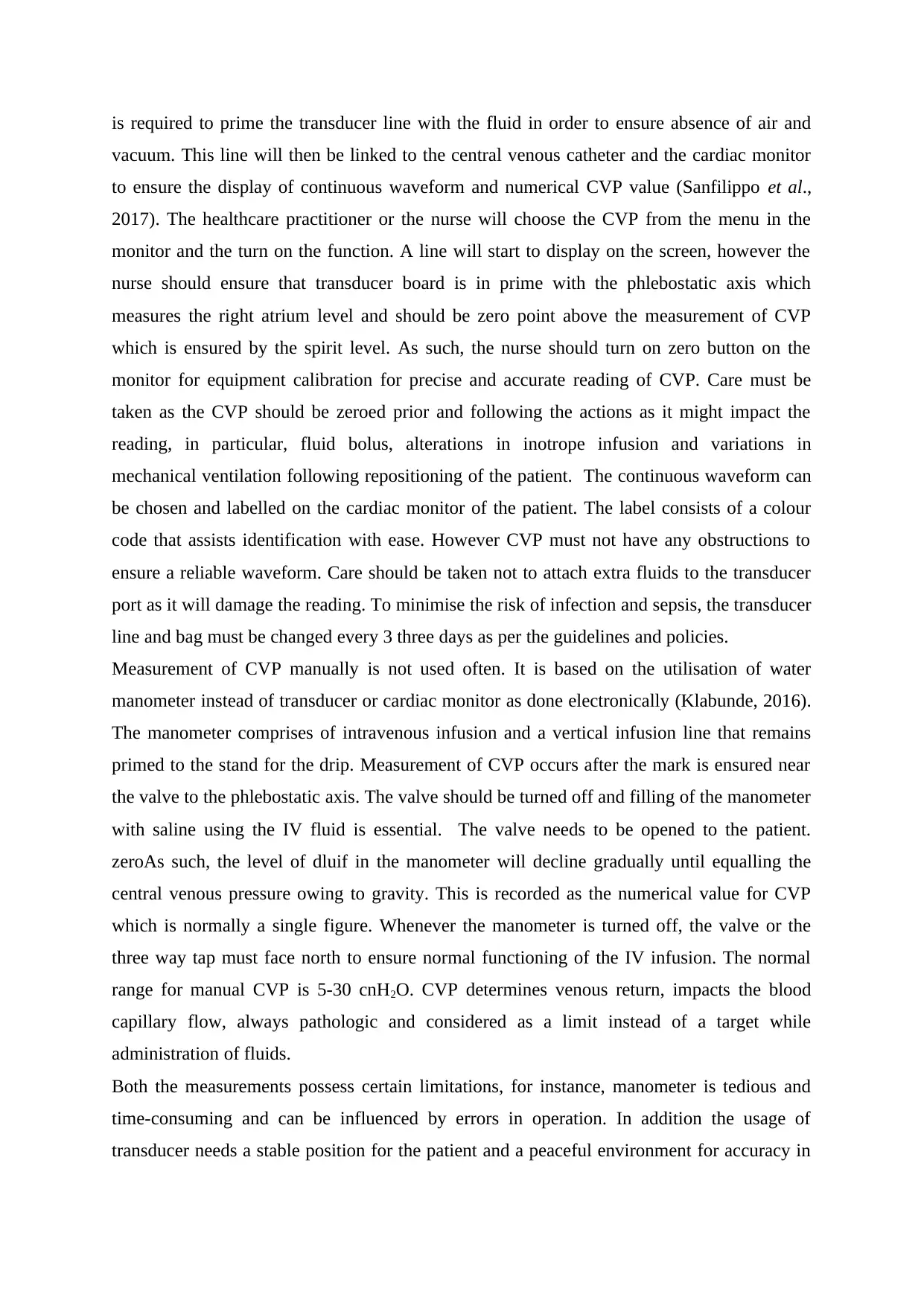
is required to prime the transducer line with the fluid in order to ensure absence of air and
vacuum. This line will then be linked to the central venous catheter and the cardiac monitor
to ensure the display of continuous waveform and numerical CVP value (Sanfilippo et al.,
2017). The healthcare practitioner or the nurse will choose the CVP from the menu in the
monitor and the turn on the function. A line will start to display on the screen, however the
nurse should ensure that transducer board is in prime with the phlebostatic axis which
measures the right atrium level and should be zero point above the measurement of CVP
which is ensured by the spirit level. As such, the nurse should turn on zero button on the
monitor for equipment calibration for precise and accurate reading of CVP. Care must be
taken as the CVP should be zeroed prior and following the actions as it might impact the
reading, in particular, fluid bolus, alterations in inotrope infusion and variations in
mechanical ventilation following repositioning of the patient. The continuous waveform can
be chosen and labelled on the cardiac monitor of the patient. The label consists of a colour
code that assists identification with ease. However CVP must not have any obstructions to
ensure a reliable waveform. Care should be taken not to attach extra fluids to the transducer
port as it will damage the reading. To minimise the risk of infection and sepsis, the transducer
line and bag must be changed every 3 three days as per the guidelines and policies.
Measurement of CVP manually is not used often. It is based on the utilisation of water
manometer instead of transducer or cardiac monitor as done electronically (Klabunde, 2016).
The manometer comprises of intravenous infusion and a vertical infusion line that remains
primed to the stand for the drip. Measurement of CVP occurs after the mark is ensured near
the valve to the phlebostatic axis. The valve should be turned off and filling of the manometer
with saline using the IV fluid is essential. The valve needs to be opened to the patient.
zeroAs such, the level of dluif in the manometer will decline gradually until equalling the
central venous pressure owing to gravity. This is recorded as the numerical value for CVP
which is normally a single figure. Whenever the manometer is turned off, the valve or the
three way tap must face north to ensure normal functioning of the IV infusion. The normal
range for manual CVP is 5-30 cnH2O. CVP determines venous return, impacts the blood
capillary flow, always pathologic and considered as a limit instead of a target while
administration of fluids.
Both the measurements possess certain limitations, for instance, manometer is tedious and
time-consuming and can be influenced by errors in operation. In addition the usage of
transducer needs a stable position for the patient and a peaceful environment for accuracy in
vacuum. This line will then be linked to the central venous catheter and the cardiac monitor
to ensure the display of continuous waveform and numerical CVP value (Sanfilippo et al.,
2017). The healthcare practitioner or the nurse will choose the CVP from the menu in the
monitor and the turn on the function. A line will start to display on the screen, however the
nurse should ensure that transducer board is in prime with the phlebostatic axis which
measures the right atrium level and should be zero point above the measurement of CVP
which is ensured by the spirit level. As such, the nurse should turn on zero button on the
monitor for equipment calibration for precise and accurate reading of CVP. Care must be
taken as the CVP should be zeroed prior and following the actions as it might impact the
reading, in particular, fluid bolus, alterations in inotrope infusion and variations in
mechanical ventilation following repositioning of the patient. The continuous waveform can
be chosen and labelled on the cardiac monitor of the patient. The label consists of a colour
code that assists identification with ease. However CVP must not have any obstructions to
ensure a reliable waveform. Care should be taken not to attach extra fluids to the transducer
port as it will damage the reading. To minimise the risk of infection and sepsis, the transducer
line and bag must be changed every 3 three days as per the guidelines and policies.
Measurement of CVP manually is not used often. It is based on the utilisation of water
manometer instead of transducer or cardiac monitor as done electronically (Klabunde, 2016).
The manometer comprises of intravenous infusion and a vertical infusion line that remains
primed to the stand for the drip. Measurement of CVP occurs after the mark is ensured near
the valve to the phlebostatic axis. The valve should be turned off and filling of the manometer
with saline using the IV fluid is essential. The valve needs to be opened to the patient.
zeroAs such, the level of dluif in the manometer will decline gradually until equalling the
central venous pressure owing to gravity. This is recorded as the numerical value for CVP
which is normally a single figure. Whenever the manometer is turned off, the valve or the
three way tap must face north to ensure normal functioning of the IV infusion. The normal
range for manual CVP is 5-30 cnH2O. CVP determines venous return, impacts the blood
capillary flow, always pathologic and considered as a limit instead of a target while
administration of fluids.
Both the measurements possess certain limitations, for instance, manometer is tedious and
time-consuming and can be influenced by errors in operation. In addition the usage of
transducer needs a stable position for the patient and a peaceful environment for accuracy in
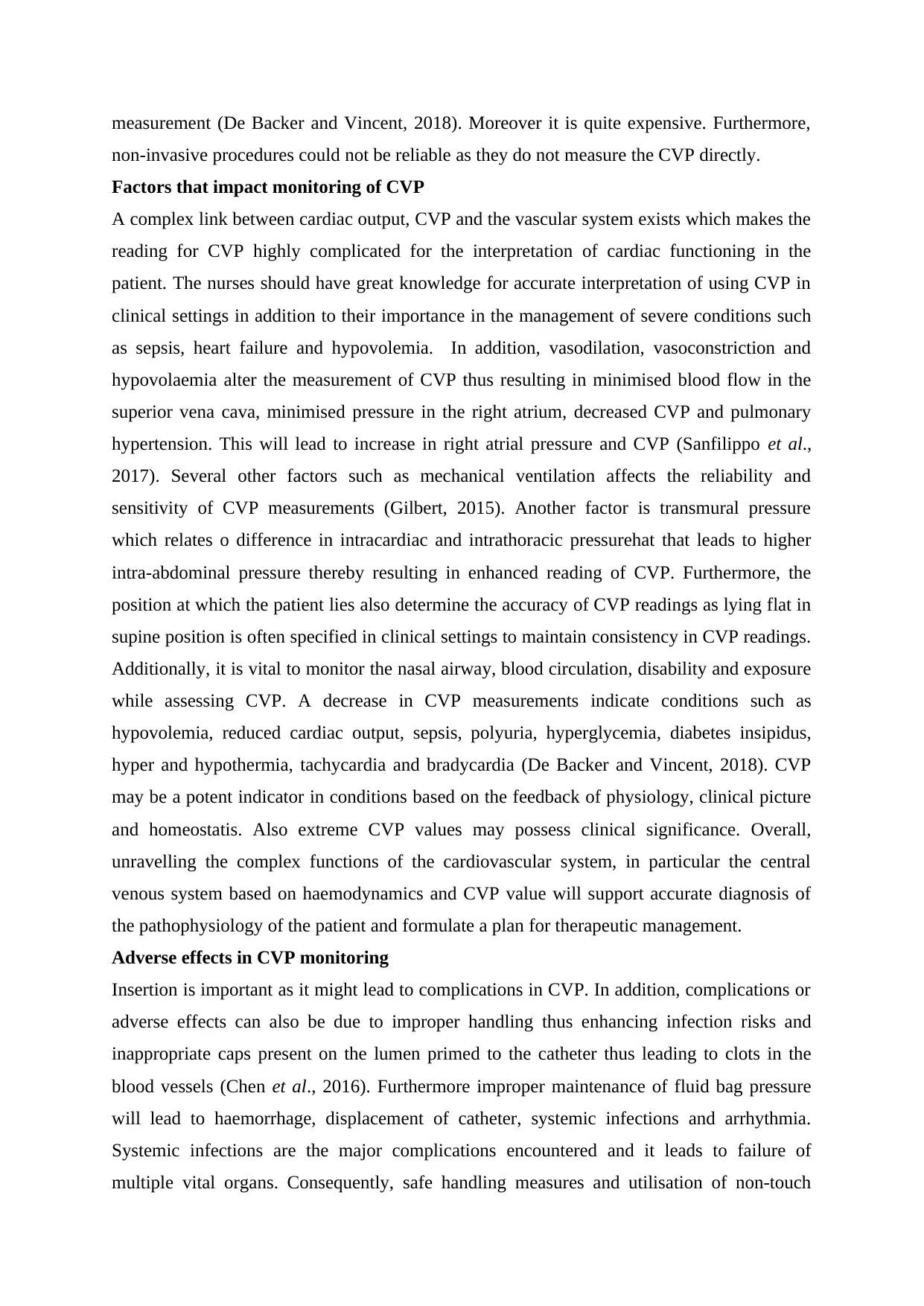
measurement (De Backer and Vincent, 2018). Moreover it is quite expensive. Furthermore,
non-invasive procedures could not be reliable as they do not measure the CVP directly.
Factors that impact monitoring of CVP
A complex link between cardiac output, CVP and the vascular system exists which makes the
reading for CVP highly complicated for the interpretation of cardiac functioning in the
patient. The nurses should have great knowledge for accurate interpretation of using CVP in
clinical settings in addition to their importance in the management of severe conditions such
as sepsis, heart failure and hypovolemia. In addition, vasodilation, vasoconstriction and
hypovolaemia alter the measurement of CVP thus resulting in minimised blood flow in the
superior vena cava, minimised pressure in the right atrium, decreased CVP and pulmonary
hypertension. This will lead to increase in right atrial pressure and CVP (Sanfilippo et al.,
2017). Several other factors such as mechanical ventilation affects the reliability and
sensitivity of CVP measurements (Gilbert, 2015). Another factor is transmural pressure
which relates o difference in intracardiac and intrathoracic pressurehat that leads to higher
intra-abdominal pressure thereby resulting in enhanced reading of CVP. Furthermore, the
position at which the patient lies also determine the accuracy of CVP readings as lying flat in
supine position is often specified in clinical settings to maintain consistency in CVP readings.
Additionally, it is vital to monitor the nasal airway, blood circulation, disability and exposure
while assessing CVP. A decrease in CVP measurements indicate conditions such as
hypovolemia, reduced cardiac output, sepsis, polyuria, hyperglycemia, diabetes insipidus,
hyper and hypothermia, tachycardia and bradycardia (De Backer and Vincent, 2018). CVP
may be a potent indicator in conditions based on the feedback of physiology, clinical picture
and homeostatis. Also extreme CVP values may possess clinical significance. Overall,
unravelling the complex functions of the cardiovascular system, in particular the central
venous system based on haemodynamics and CVP value will support accurate diagnosis of
the pathophysiology of the patient and formulate a plan for therapeutic management.
Adverse effects in CVP monitoring
Insertion is important as it might lead to complications in CVP. In addition, complications or
adverse effects can also be due to improper handling thus enhancing infection risks and
inappropriate caps present on the lumen primed to the catheter thus leading to clots in the
blood vessels (Chen et al., 2016). Furthermore improper maintenance of fluid bag pressure
will lead to haemorrhage, displacement of catheter, systemic infections and arrhythmia.
Systemic infections are the major complications encountered and it leads to failure of
multiple vital organs. Consequently, safe handling measures and utilisation of non-touch
non-invasive procedures could not be reliable as they do not measure the CVP directly.
Factors that impact monitoring of CVP
A complex link between cardiac output, CVP and the vascular system exists which makes the
reading for CVP highly complicated for the interpretation of cardiac functioning in the
patient. The nurses should have great knowledge for accurate interpretation of using CVP in
clinical settings in addition to their importance in the management of severe conditions such
as sepsis, heart failure and hypovolemia. In addition, vasodilation, vasoconstriction and
hypovolaemia alter the measurement of CVP thus resulting in minimised blood flow in the
superior vena cava, minimised pressure in the right atrium, decreased CVP and pulmonary
hypertension. This will lead to increase in right atrial pressure and CVP (Sanfilippo et al.,
2017). Several other factors such as mechanical ventilation affects the reliability and
sensitivity of CVP measurements (Gilbert, 2015). Another factor is transmural pressure
which relates o difference in intracardiac and intrathoracic pressurehat that leads to higher
intra-abdominal pressure thereby resulting in enhanced reading of CVP. Furthermore, the
position at which the patient lies also determine the accuracy of CVP readings as lying flat in
supine position is often specified in clinical settings to maintain consistency in CVP readings.
Additionally, it is vital to monitor the nasal airway, blood circulation, disability and exposure
while assessing CVP. A decrease in CVP measurements indicate conditions such as
hypovolemia, reduced cardiac output, sepsis, polyuria, hyperglycemia, diabetes insipidus,
hyper and hypothermia, tachycardia and bradycardia (De Backer and Vincent, 2018). CVP
may be a potent indicator in conditions based on the feedback of physiology, clinical picture
and homeostatis. Also extreme CVP values may possess clinical significance. Overall,
unravelling the complex functions of the cardiovascular system, in particular the central
venous system based on haemodynamics and CVP value will support accurate diagnosis of
the pathophysiology of the patient and formulate a plan for therapeutic management.
Adverse effects in CVP monitoring
Insertion is important as it might lead to complications in CVP. In addition, complications or
adverse effects can also be due to improper handling thus enhancing infection risks and
inappropriate caps present on the lumen primed to the catheter thus leading to clots in the
blood vessels (Chen et al., 2016). Furthermore improper maintenance of fluid bag pressure
will lead to haemorrhage, displacement of catheter, systemic infections and arrhythmia.
Systemic infections are the major complications encountered and it leads to failure of
multiple vital organs. Consequently, safe handling measures and utilisation of non-touch
⊘ This is a preview!⊘
Do you want full access?
Subscribe today to unlock all pages.

Trusted by 1+ million students worldwide
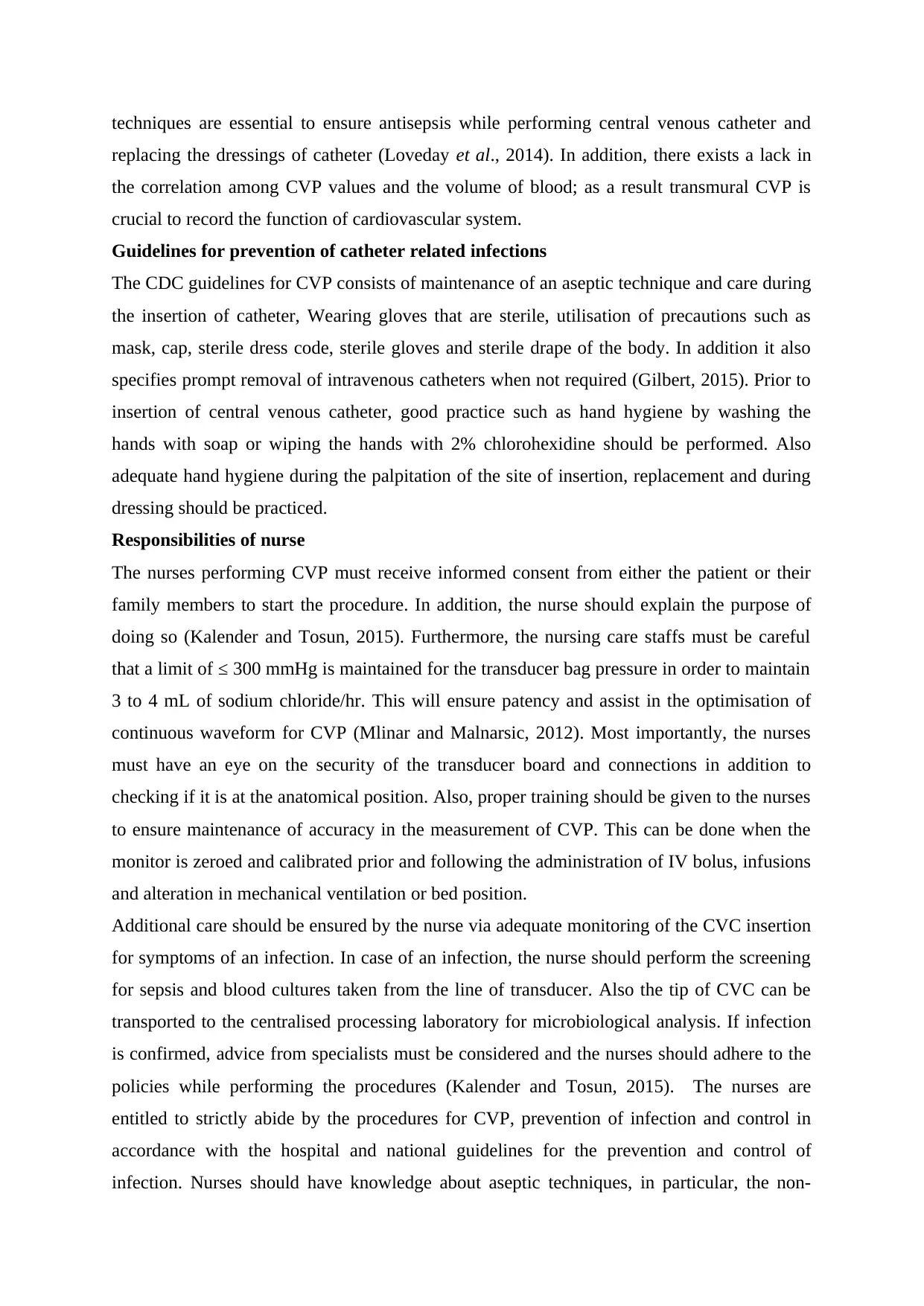
techniques are essential to ensure antisepsis while performing central venous catheter and
replacing the dressings of catheter (Loveday et al., 2014). In addition, there exists a lack in
the correlation among CVP values and the volume of blood; as a result transmural CVP is
crucial to record the function of cardiovascular system.
Guidelines for prevention of catheter related infections
The CDC guidelines for CVP consists of maintenance of an aseptic technique and care during
the insertion of catheter, Wearing gloves that are sterile, utilisation of precautions such as
mask, cap, sterile dress code, sterile gloves and sterile drape of the body. In addition it also
specifies prompt removal of intravenous catheters when not required (Gilbert, 2015). Prior to
insertion of central venous catheter, good practice such as hand hygiene by washing the
hands with soap or wiping the hands with 2% chlorohexidine should be performed. Also
adequate hand hygiene during the palpitation of the site of insertion, replacement and during
dressing should be practiced.
Responsibilities of nurse
The nurses performing CVP must receive informed consent from either the patient or their
family members to start the procedure. In addition, the nurse should explain the purpose of
doing so (Kalender and Tosun, 2015). Furthermore, the nursing care staffs must be careful
that a limit of ≤ 300 mmHg is maintained for the transducer bag pressure in order to maintain
3 to 4 mL of sodium chloride/hr. This will ensure patency and assist in the optimisation of
continuous waveform for CVP (Mlinar and Malnarsic, 2012). Most importantly, the nurses
must have an eye on the security of the transducer board and connections in addition to
checking if it is at the anatomical position. Also, proper training should be given to the nurses
to ensure maintenance of accuracy in the measurement of CVP. This can be done when the
monitor is zeroed and calibrated prior and following the administration of IV bolus, infusions
and alteration in mechanical ventilation or bed position.
Additional care should be ensured by the nurse via adequate monitoring of the CVC insertion
for symptoms of an infection. In case of an infection, the nurse should perform the screening
for sepsis and blood cultures taken from the line of transducer. Also the tip of CVC can be
transported to the centralised processing laboratory for microbiological analysis. If infection
is confirmed, advice from specialists must be considered and the nurses should adhere to the
policies while performing the procedures (Kalender and Tosun, 2015). The nurses are
entitled to strictly abide by the procedures for CVP, prevention of infection and control in
accordance with the hospital and national guidelines for the prevention and control of
infection. Nurses should have knowledge about aseptic techniques, in particular, the non-
replacing the dressings of catheter (Loveday et al., 2014). In addition, there exists a lack in
the correlation among CVP values and the volume of blood; as a result transmural CVP is
crucial to record the function of cardiovascular system.
Guidelines for prevention of catheter related infections
The CDC guidelines for CVP consists of maintenance of an aseptic technique and care during
the insertion of catheter, Wearing gloves that are sterile, utilisation of precautions such as
mask, cap, sterile dress code, sterile gloves and sterile drape of the body. In addition it also
specifies prompt removal of intravenous catheters when not required (Gilbert, 2015). Prior to
insertion of central venous catheter, good practice such as hand hygiene by washing the
hands with soap or wiping the hands with 2% chlorohexidine should be performed. Also
adequate hand hygiene during the palpitation of the site of insertion, replacement and during
dressing should be practiced.
Responsibilities of nurse
The nurses performing CVP must receive informed consent from either the patient or their
family members to start the procedure. In addition, the nurse should explain the purpose of
doing so (Kalender and Tosun, 2015). Furthermore, the nursing care staffs must be careful
that a limit of ≤ 300 mmHg is maintained for the transducer bag pressure in order to maintain
3 to 4 mL of sodium chloride/hr. This will ensure patency and assist in the optimisation of
continuous waveform for CVP (Mlinar and Malnarsic, 2012). Most importantly, the nurses
must have an eye on the security of the transducer board and connections in addition to
checking if it is at the anatomical position. Also, proper training should be given to the nurses
to ensure maintenance of accuracy in the measurement of CVP. This can be done when the
monitor is zeroed and calibrated prior and following the administration of IV bolus, infusions
and alteration in mechanical ventilation or bed position.
Additional care should be ensured by the nurse via adequate monitoring of the CVC insertion
for symptoms of an infection. In case of an infection, the nurse should perform the screening
for sepsis and blood cultures taken from the line of transducer. Also the tip of CVC can be
transported to the centralised processing laboratory for microbiological analysis. If infection
is confirmed, advice from specialists must be considered and the nurses should adhere to the
policies while performing the procedures (Kalender and Tosun, 2015). The nurses are
entitled to strictly abide by the procedures for CVP, prevention of infection and control in
accordance with the hospital and national guidelines for the prevention and control of
infection. Nurses should have knowledge about aseptic techniques, in particular, the non-
Paraphrase This Document
Need a fresh take? Get an instant paraphrase of this document with our AI Paraphraser
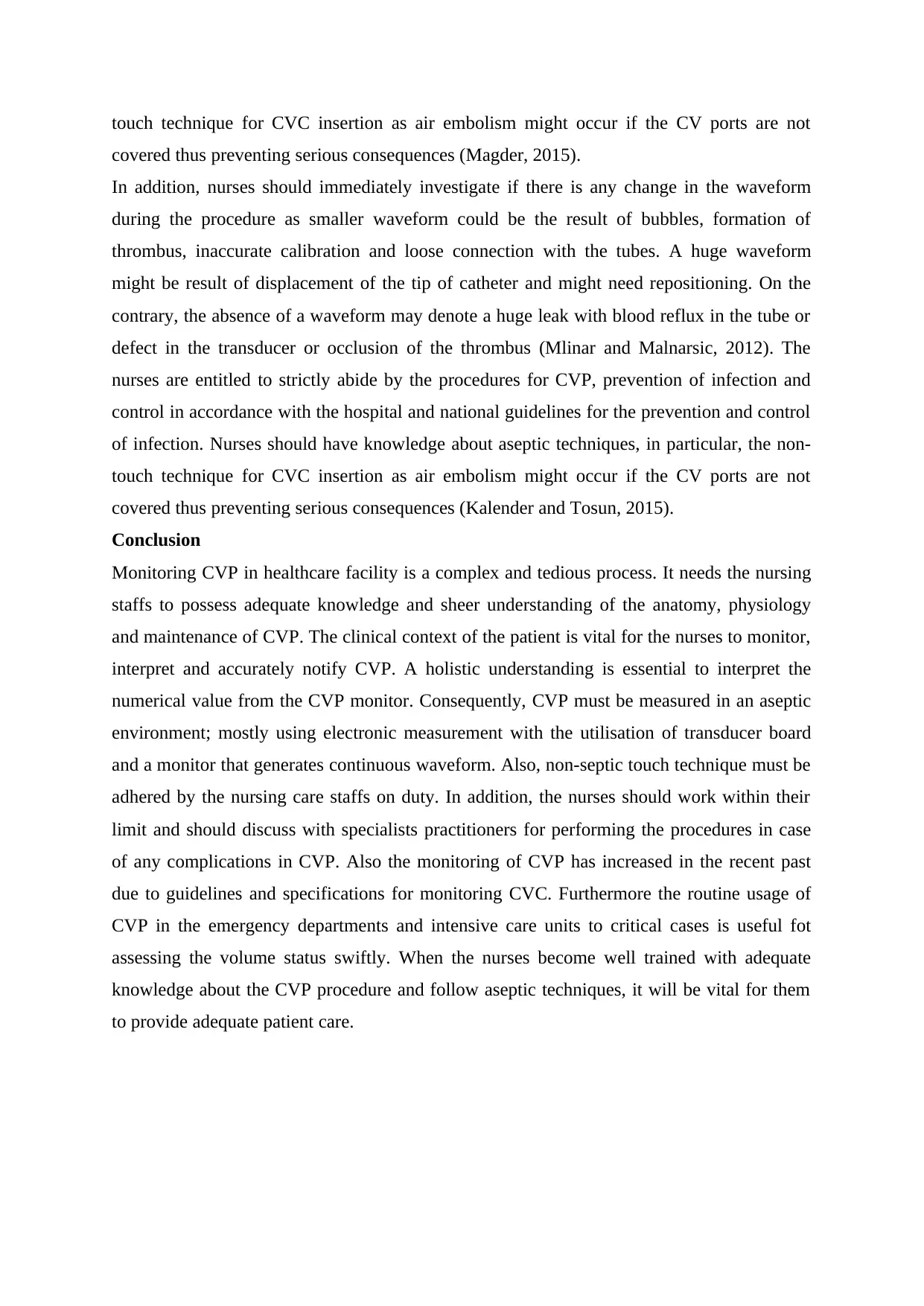
touch technique for CVC insertion as air embolism might occur if the CV ports are not
covered thus preventing serious consequences (Magder, 2015).
In addition, nurses should immediately investigate if there is any change in the waveform
during the procedure as smaller waveform could be the result of bubbles, formation of
thrombus, inaccurate calibration and loose connection with the tubes. A huge waveform
might be result of displacement of the tip of catheter and might need repositioning. On the
contrary, the absence of a waveform may denote a huge leak with blood reflux in the tube or
defect in the transducer or occlusion of the thrombus (Mlinar and Malnarsic, 2012). The
nurses are entitled to strictly abide by the procedures for CVP, prevention of infection and
control in accordance with the hospital and national guidelines for the prevention and control
of infection. Nurses should have knowledge about aseptic techniques, in particular, the non-
touch technique for CVC insertion as air embolism might occur if the CV ports are not
covered thus preventing serious consequences (Kalender and Tosun, 2015).
Conclusion
Monitoring CVP in healthcare facility is a complex and tedious process. It needs the nursing
staffs to possess adequate knowledge and sheer understanding of the anatomy, physiology
and maintenance of CVP. The clinical context of the patient is vital for the nurses to monitor,
interpret and accurately notify CVP. A holistic understanding is essential to interpret the
numerical value from the CVP monitor. Consequently, CVP must be measured in an aseptic
environment; mostly using electronic measurement with the utilisation of transducer board
and a monitor that generates continuous waveform. Also, non-septic touch technique must be
adhered by the nursing care staffs on duty. In addition, the nurses should work within their
limit and should discuss with specialists practitioners for performing the procedures in case
of any complications in CVP. Also the monitoring of CVP has increased in the recent past
due to guidelines and specifications for monitoring CVC. Furthermore the routine usage of
CVP in the emergency departments and intensive care units to critical cases is useful fot
assessing the volume status swiftly. When the nurses become well trained with adequate
knowledge about the CVP procedure and follow aseptic techniques, it will be vital for them
to provide adequate patient care.
covered thus preventing serious consequences (Magder, 2015).
In addition, nurses should immediately investigate if there is any change in the waveform
during the procedure as smaller waveform could be the result of bubbles, formation of
thrombus, inaccurate calibration and loose connection with the tubes. A huge waveform
might be result of displacement of the tip of catheter and might need repositioning. On the
contrary, the absence of a waveform may denote a huge leak with blood reflux in the tube or
defect in the transducer or occlusion of the thrombus (Mlinar and Malnarsic, 2012). The
nurses are entitled to strictly abide by the procedures for CVP, prevention of infection and
control in accordance with the hospital and national guidelines for the prevention and control
of infection. Nurses should have knowledge about aseptic techniques, in particular, the non-
touch technique for CVC insertion as air embolism might occur if the CV ports are not
covered thus preventing serious consequences (Kalender and Tosun, 2015).
Conclusion
Monitoring CVP in healthcare facility is a complex and tedious process. It needs the nursing
staffs to possess adequate knowledge and sheer understanding of the anatomy, physiology
and maintenance of CVP. The clinical context of the patient is vital for the nurses to monitor,
interpret and accurately notify CVP. A holistic understanding is essential to interpret the
numerical value from the CVP monitor. Consequently, CVP must be measured in an aseptic
environment; mostly using electronic measurement with the utilisation of transducer board
and a monitor that generates continuous waveform. Also, non-septic touch technique must be
adhered by the nursing care staffs on duty. In addition, the nurses should work within their
limit and should discuss with specialists practitioners for performing the procedures in case
of any complications in CVP. Also the monitoring of CVP has increased in the recent past
due to guidelines and specifications for monitoring CVC. Furthermore the routine usage of
CVP in the emergency departments and intensive care units to critical cases is useful fot
assessing the volume status swiftly. When the nurses become well trained with adequate
knowledge about the CVP procedure and follow aseptic techniques, it will be vital for them
to provide adequate patient care.
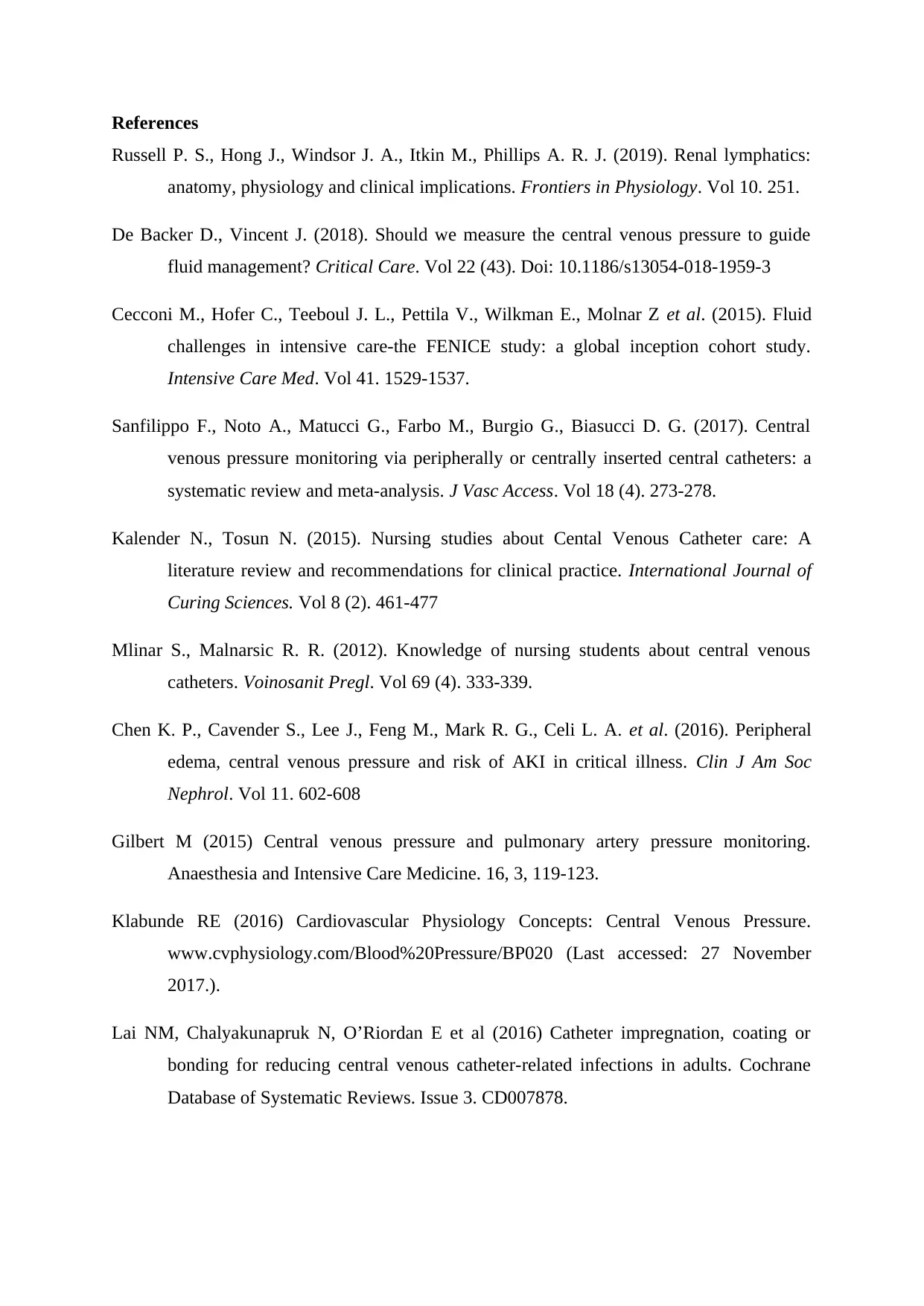
References
Russell P. S., Hong J., Windsor J. A., Itkin M., Phillips A. R. J. (2019). Renal lymphatics:
anatomy, physiology and clinical implications. Frontiers in Physiology. Vol 10. 251.
De Backer D., Vincent J. (2018). Should we measure the central venous pressure to guide
fluid management? Critical Care. Vol 22 (43). Doi: 10.1186/s13054-018-1959-3
Cecconi M., Hofer C., Teeboul J. L., Pettila V., Wilkman E., Molnar Z et al. (2015). Fluid
challenges in intensive care-the FENICE study: a global inception cohort study.
Intensive Care Med. Vol 41. 1529-1537.
Sanfilippo F., Noto A., Matucci G., Farbo M., Burgio G., Biasucci D. G. (2017). Central
venous pressure monitoring via peripherally or centrally inserted central catheters: a
systematic review and meta-analysis. J Vasc Access. Vol 18 (4). 273-278.
Kalender N., Tosun N. (2015). Nursing studies about Cental Venous Catheter care: A
literature review and recommendations for clinical practice. International Journal of
Curing Sciences. Vol 8 (2). 461-477
Mlinar S., Malnarsic R. R. (2012). Knowledge of nursing students about central venous
catheters. Voinosanit Pregl. Vol 69 (4). 333-339.
Chen K. P., Cavender S., Lee J., Feng M., Mark R. G., Celi L. A. et al. (2016). Peripheral
edema, central venous pressure and risk of AKI in critical illness. Clin J Am Soc
Nephrol. Vol 11. 602-608
Gilbert M (2015) Central venous pressure and pulmonary artery pressure monitoring.
Anaesthesia and Intensive Care Medicine. 16, 3, 119-123.
Klabunde RE (2016) Cardiovascular Physiology Concepts: Central Venous Pressure.
www.cvphysiology.com/Blood%20Pressure/BP020 (Last accessed: 27 November
2017.).
Lai NM, Chalyakunapruk N, O’Riordan E et al (2016) Catheter impregnation, coating or
bonding for reducing central venous catheter-related infections in adults. Cochrane
Database of Systematic Reviews. Issue 3. CD007878.
Russell P. S., Hong J., Windsor J. A., Itkin M., Phillips A. R. J. (2019). Renal lymphatics:
anatomy, physiology and clinical implications. Frontiers in Physiology. Vol 10. 251.
De Backer D., Vincent J. (2018). Should we measure the central venous pressure to guide
fluid management? Critical Care. Vol 22 (43). Doi: 10.1186/s13054-018-1959-3
Cecconi M., Hofer C., Teeboul J. L., Pettila V., Wilkman E., Molnar Z et al. (2015). Fluid
challenges in intensive care-the FENICE study: a global inception cohort study.
Intensive Care Med. Vol 41. 1529-1537.
Sanfilippo F., Noto A., Matucci G., Farbo M., Burgio G., Biasucci D. G. (2017). Central
venous pressure monitoring via peripherally or centrally inserted central catheters: a
systematic review and meta-analysis. J Vasc Access. Vol 18 (4). 273-278.
Kalender N., Tosun N. (2015). Nursing studies about Cental Venous Catheter care: A
literature review and recommendations for clinical practice. International Journal of
Curing Sciences. Vol 8 (2). 461-477
Mlinar S., Malnarsic R. R. (2012). Knowledge of nursing students about central venous
catheters. Voinosanit Pregl. Vol 69 (4). 333-339.
Chen K. P., Cavender S., Lee J., Feng M., Mark R. G., Celi L. A. et al. (2016). Peripheral
edema, central venous pressure and risk of AKI in critical illness. Clin J Am Soc
Nephrol. Vol 11. 602-608
Gilbert M (2015) Central venous pressure and pulmonary artery pressure monitoring.
Anaesthesia and Intensive Care Medicine. 16, 3, 119-123.
Klabunde RE (2016) Cardiovascular Physiology Concepts: Central Venous Pressure.
www.cvphysiology.com/Blood%20Pressure/BP020 (Last accessed: 27 November
2017.).
Lai NM, Chalyakunapruk N, O’Riordan E et al (2016) Catheter impregnation, coating or
bonding for reducing central venous catheter-related infections in adults. Cochrane
Database of Systematic Reviews. Issue 3. CD007878.
⊘ This is a preview!⊘
Do you want full access?
Subscribe today to unlock all pages.

Trusted by 1+ million students worldwide
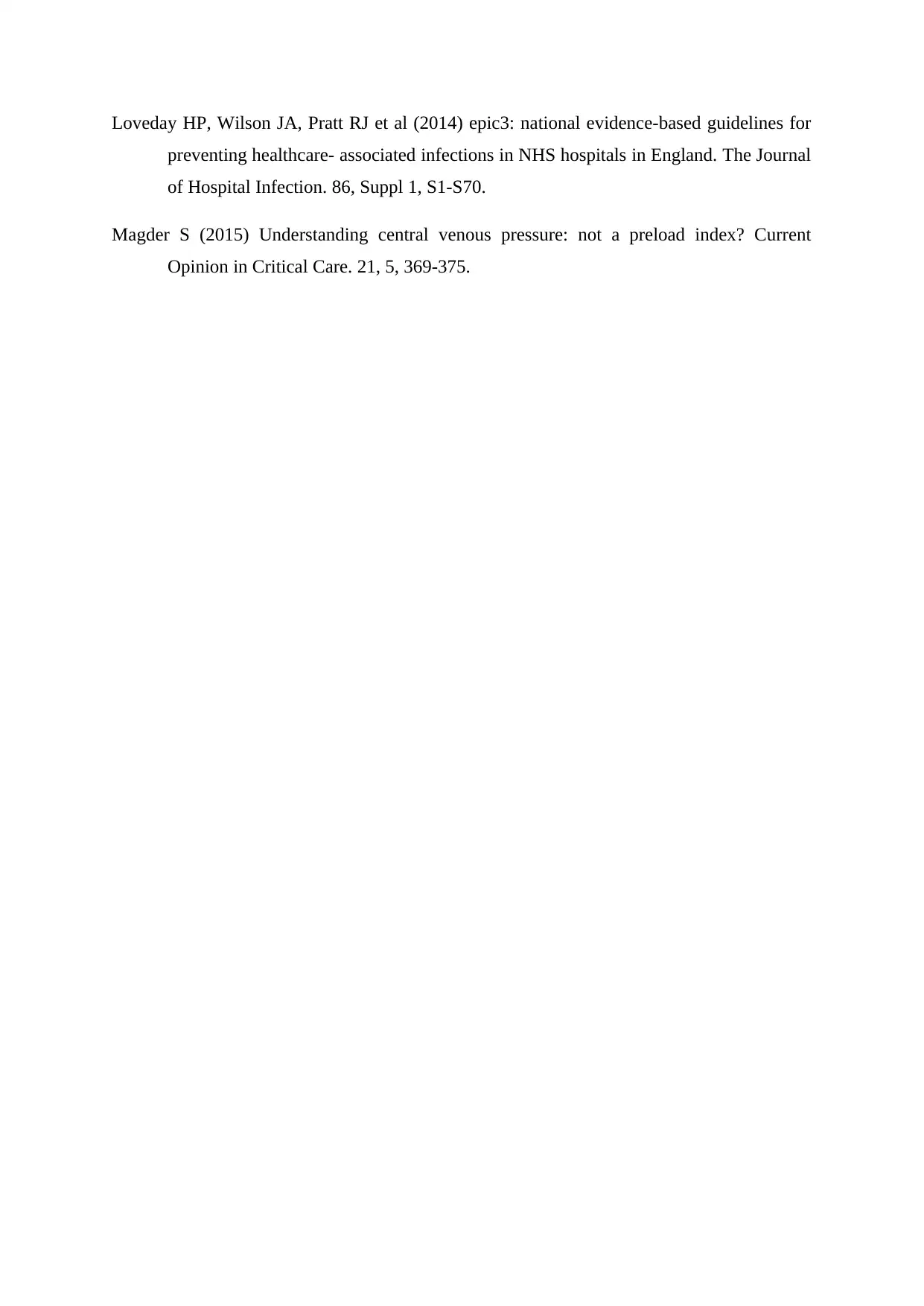
Loveday HP, Wilson JA, Pratt RJ et al (2014) epic3: national evidence-based guidelines for
preventing healthcare- associated infections in NHS hospitals in England. The Journal
of Hospital Infection. 86, Suppl 1, S1-S70.
Magder S (2015) Understanding central venous pressure: not a preload index? Current
Opinion in Critical Care. 21, 5, 369-375.
preventing healthcare- associated infections in NHS hospitals in England. The Journal
of Hospital Infection. 86, Suppl 1, S1-S70.
Magder S (2015) Understanding central venous pressure: not a preload index? Current
Opinion in Critical Care. 21, 5, 369-375.
1 out of 7
Related Documents
Your All-in-One AI-Powered Toolkit for Academic Success.
+13062052269
info@desklib.com
Available 24*7 on WhatsApp / Email
![[object Object]](/_next/static/media/star-bottom.7253800d.svg)
Unlock your academic potential
Copyright © 2020–2025 A2Z Services. All Rights Reserved. Developed and managed by ZUCOL.




